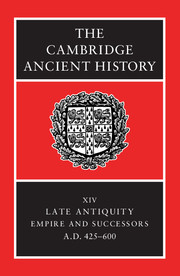Book contents
- Frontmatter
- PART I CHRONOLOGICAL OVERVIEW
- PART II GOVERNMENT AND INSTITUTIONS
- PART III EAST AND WEST: ECONOMY AND SOCIETY
- PART IV THE PROVINCES AND THE NON-ROMAN WORLD
- PART V RELIGION AND CULTURE
- 24 The organization of the church
- 25 Monasticism
- 26 Holy Men
- 27 The definition and enforcement of orthodoxy
- 28 Philosophy and philosophical schools
- 29 Education in the Roman empire
- 30 The visual arts
- 31 Building and architecture
- Conclusion
- Chronological Table
- BIBLIOGRAPHY
- Index
- References
29 - Education in the Roman empire
from PART V - RELIGION AND CULTURE
Published online by Cambridge University Press: 28 March 2008
- Frontmatter
- PART I CHRONOLOGICAL OVERVIEW
- PART II GOVERNMENT AND INSTITUTIONS
- PART III EAST AND WEST: ECONOMY AND SOCIETY
- PART IV THE PROVINCES AND THE NON-ROMAN WORLD
- PART V RELIGION AND CULTURE
- 24 The organization of the church
- 25 Monasticism
- 26 Holy Men
- 27 The definition and enforcement of orthodoxy
- 28 Philosophy and philosophical schools
- 29 Education in the Roman empire
- 30 The visual arts
- 31 Building and architecture
- Conclusion
- Chronological Table
- BIBLIOGRAPHY
- Index
- References
Summary
Throughout the fifth and sixth centuries a.d., and to some extent later also, the education of the young followed patterns established in outline almost a thousand years earlier. Changes in content and in institutional arrangements had certainly taken place during the long period. The gradual disappearance in the Greek world of the element of physical training and of the institution which provided for it, the gymnasium, is an example. But change on the whole had been slow and almost imperceptible. Traditional attitudes, methods and values had sunk deep roots in ancient society, roots which remained relatively undisturbed by the social, political and religious changes of the period. Education of all kinds was marked by rigid conservatism. There was no resistance to innovation because there was no innovation to resist. In the words of a recent study, ‘Late antique schools of grammar and rhetoric were sound-proof against the outside world, their methods and their status largely untouched by the profound political and religious changes taking place around them.’ Such general statements call for some qualification when one looks more closely at particular regions, periods or ethnic groups, but on the whole they provide a valid and important characterization of late antique education and of the culture which it reflected and perpetuated.
- Type
- Chapter
- Information
- The Cambridge Ancient History , pp. 855 - 883Publisher: Cambridge University PressPrint publication year: 2001
References
- 2
- Cited by

